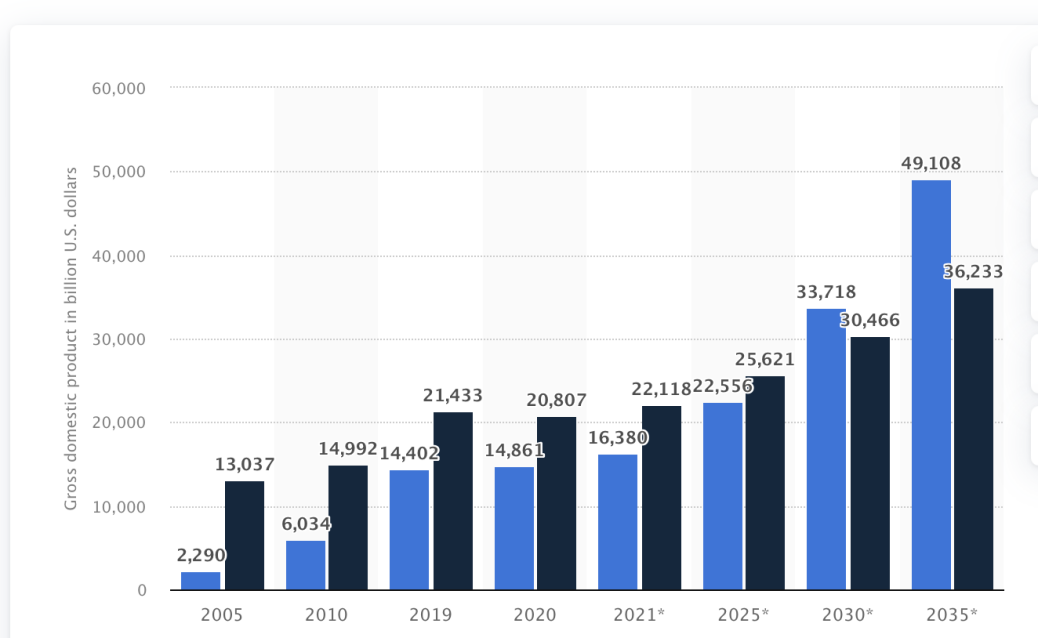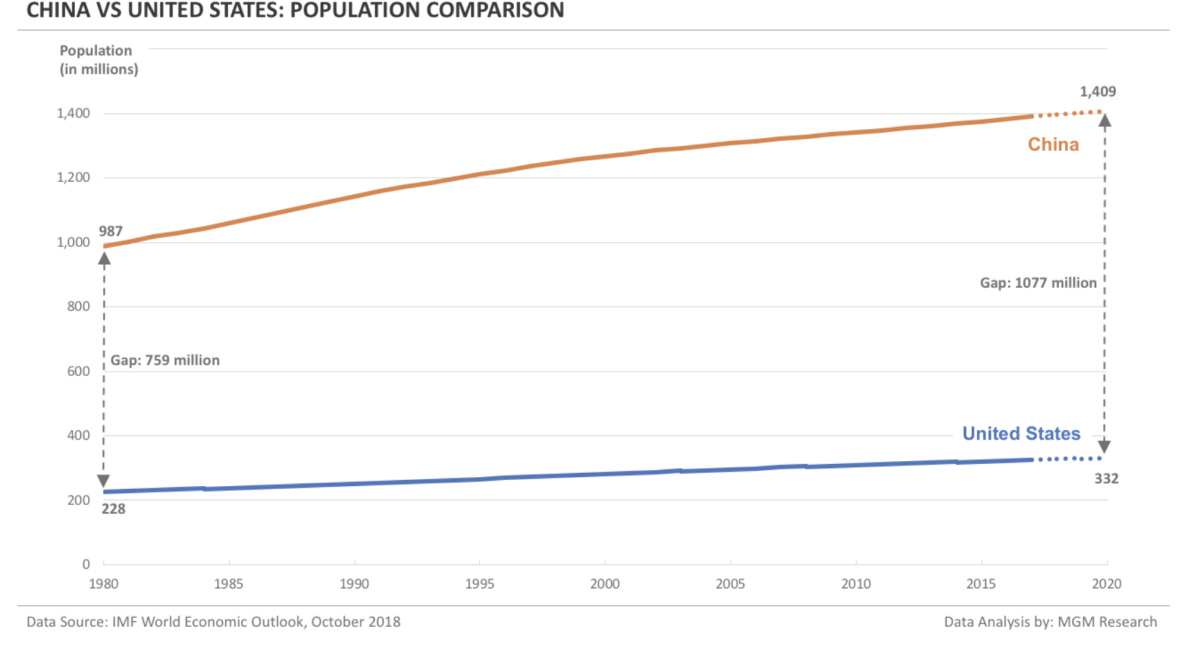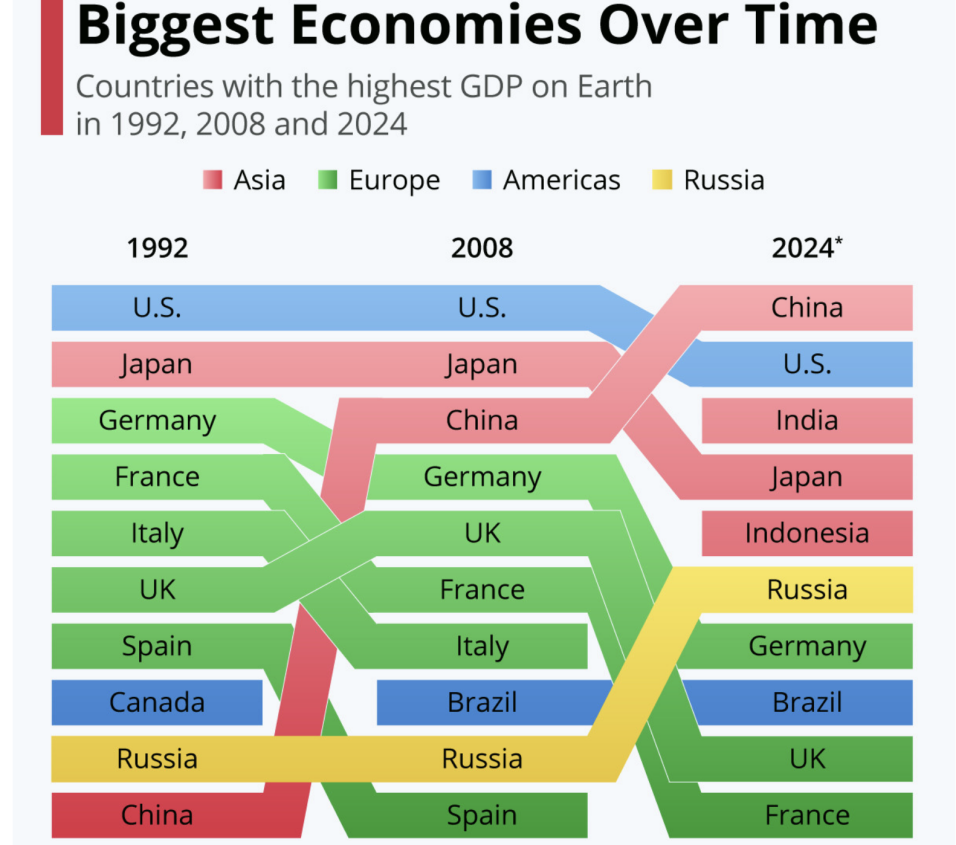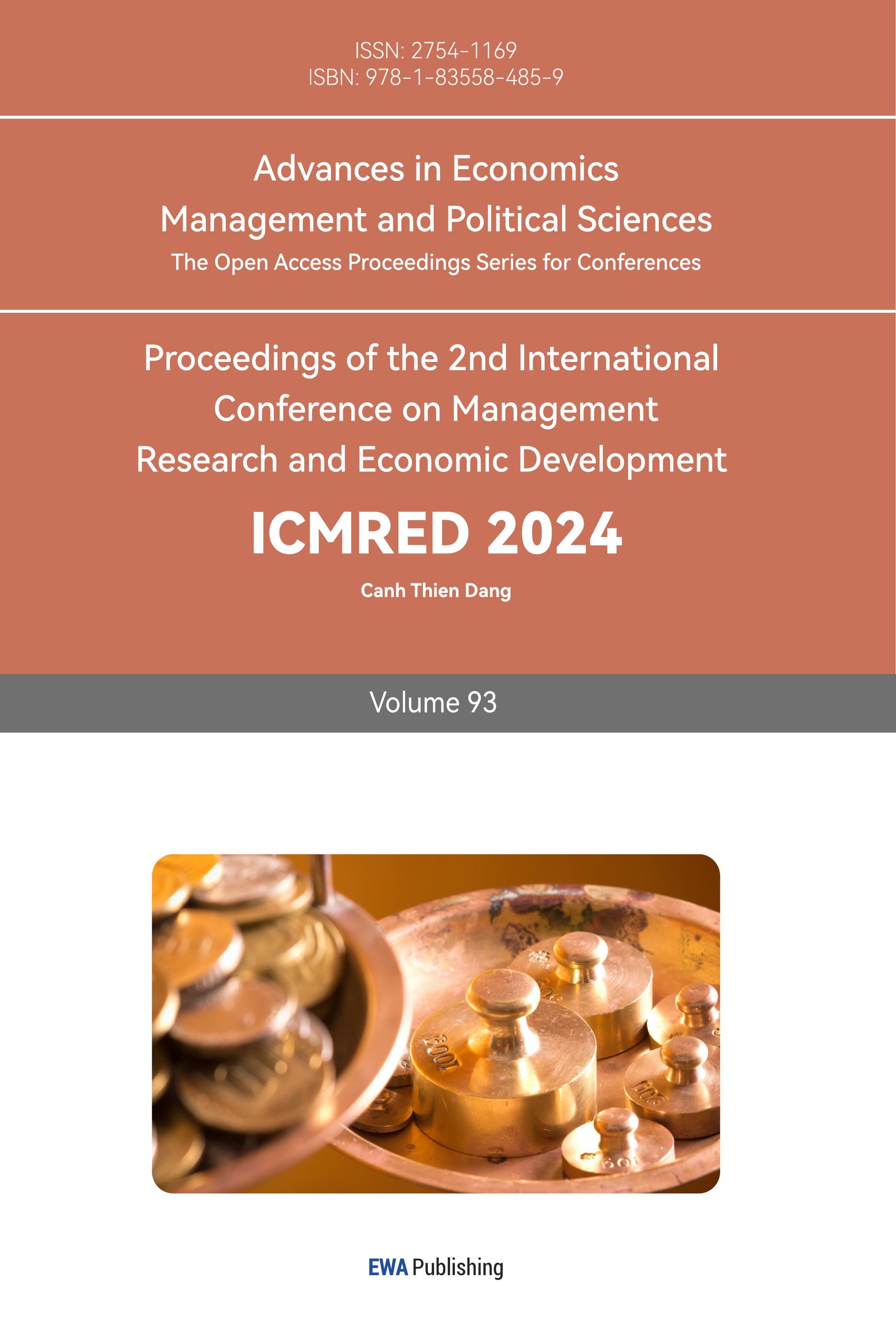1. Introduction
In the background, China and the United States, as the two countries with the largest GDP growth in recent years, have been concerned. Based on data from 2005 to 2020, China's GDP has grown from $2.3 trillion to $14.9 trillion. America's GDP grew from $13 trillion to $20.8 trillion. It is estimated that by 2030, China will surpass the United States to become the world's largest economy. As the name suggests, the topic is the changes in the GDP of China and the United States, but the focus is still on the growth trend of the GDP of the two countries. I will study my goal by quoting foreign data charts and papers. In the period after World War II, the United States held the title of "world's first economy" for a long time. Still, with the rapid development of China in the 21st century, China has become the "world's second-largest economy" that is "very likely" to surpass the United States. Moreover, the concept of GDP itself also represents the strength of national power, which can be said to affect the world situation in a disguised way. Not to mention the two world powers, it can be said that studying GDP is also a disguised way to study the world trend, which is exactly the significance of studying the changing trend of GDP
2. Analysis of the GDP

Figure 1: America GDP forecast over 2005-2035 [1].

Figure 2: Population compression in the United States and China [2].

Figure 3: Biggest Economics over 1992-2024 [3].
As shown in the figures, the paper wants to analyze the changing trend of GDP between China and the United States by comparing the changes in economic and population data from recent years to the next three years. We can start by looking at the first picture. Blue is China, black is the United States. Finally, you can see the view of this chart that China's GDP will completely surpass that of the United States in 2030, and will be much higher than that of the United States in 25 years. China is gradually moving from a huge difference between the two countries in 2005 to the number one economy by 2035. We can see the speculation and recognition of China's economic strength in this chart. Then there is the second chart, which shows the population comparison between the two countries. Let's not look at the difference in population data between the two countries after 1980, just in 1980, China had 759 million more people than the United States, and 40 years later, in 2020, the population difference between China and the United States has increased to 1.077 billion. Similar to the difference in age between people, can not be made up. The same is true of population data. Then there's the 40-year increase in the two countries' populations. Although the whole world has been affected by the COVID-19 pandemic, China's huge population base combined with strict controls has added 422 million people to its population. The U.S. population only grew by 104 million because of the epidemic. Although the United States is still the largest economy, it has also lost a lot because of the epidemic. China is also creeping up. The third picture is the most intuitive. It directly shows the GDP forecasts of multiple countries at three different times: 1992, 2008,2004. As you can see, China's rapid development, from 10th in 1992 to 3rd in 2008, is finally expected to surpass the United States in 2004, and ahead of many other countries. All these reflect the international community's recognition of China's economic potential.
2.1. Biggest Economies Over Time
According to data from the World Bank and IMF, Asian countries are expected to make up most of the top 5 countries in the world by size of GDP in 2024, (2) and China will be the largest economy. The United States will become the largest second-largest economy [4].
2.2. Population Comparison
China is a large country with 18 percent of the world's population, and daily production is closely related to individuals. And IMF forecasts China's population to reach 1.4 billion by 2020, whereas the US population will reach 332 million. (3) And this is the 2018 forecast data, but for the epidemic, perhaps China would have become the largest economy. In addition, the population itself will continue to increase, and in recent years, the value of RMB has been very stable, the US dollar has been expanding in recent years, and it is unstable, and the population growth of the United States is not fixed, it is not surprising that China surpasses it. All major websites believe that in 2024, the total number of people in the United States and China will temporarily remain in the situation of 2022. Of these, 300 million are in the United States and 1.4 billion are in China. GDP per capita will not change much from 2023. China's per capita GDP is $14,800. America's per capita GDP is $82,000. China's GDP will grow by 5.5 percent from 2023-2024. The United States, while maintaining its economic success as the largest economy, will grow by only 1.7 percent [5]. Objectively speaking, it is due to the failure to control the COVID-19 pandemic in 2020, which has caused the GDP of the United States to slow down since the pandemic. Having said the current situation, next, based on the economic numerical characteristics of China and the United States to speculate on the future economic trend of China and the United States. First, at the current pace, it is indeed highly likely that China will become the largest economy in 2025 because the United States has not fully recovered from the losses suffered after the epidemic. The Biden administration's immigration policies have led to social and environmental turmoil, as well as its aid to Ukraine and Israel. The foundation of the United States is indeed very strong, but it cannot withstand these policies. Moreover, the United States used to provide economic aid to Ukraine and Israel, but Ukraine can't do it, and it can't keep spending money, so it stopped giving aid to Ukraine. These things can be inferred from the details of objective events if you keep watching the news. To put it crudely, if this country wasn't the United States of families and businessmen, it would have been lost during the pandemic. In contrast, China fought a war for more than half a century in the 20th century, that is, the domestic situation gradually stabilized and developed steadily from the 1980s. GDP is already higher than that of the United States [6]. Moreover, the United States was not without this situation during the Bush administration, and it was during the 8 years of the Bush administration that China had the opportunity to develop and thus have the rapid development now. Moreover, some associations predict that in the next year, China is the most hopeful country to exceed 20 trillion US dollars, and the United States only has more than a 4 trillion gap [7-8].
3. Conclusion
China's economic growth has been steep since the 1990s, while India and Indonesia have even more recently entered the top 10 of the biggest economies in the world and are expected to reach ranks 3 and 5 by 2024. Asian multinationals, like China’s Huawei and India’s Tata, have already emerged in this century and more are expected to appear on the global scene. (4) The U.S. economy has expanded in recent years, and the population has not grown. The likelihood of a decline in GDP, combined with the above charts, suggests that China is well positioned to overtake the US as the largest economy. The significance of this paper is to take the two major economies in the "2023" stage as the main body to analyze the relationship between China and the United States in the future GDP position, as well as the impact of GDP strength on other large economies in the world in the future. In the future, I can also analyze GDP trends by population size, or analyze other countries with lower GDP in the top ten. The deficiency is that I have not been able to find more papers, and more mixed subjective views to write this pap.
References
[1]. Doreen Fagan, “What Is GDP, and Why Is It Important?”by March 23, 2020, https://www.weforum.org/agenda/2020/07/largest-global-economies-1992-2008-2024/
[2]. Katharina Buchholz, “China could overtake the US as the world’s largest economy by 2024” by Jul 20, 2020
[3]. China Vs United States - A GDP Comparison by Dec 21, 2018
[4]. Doreen Fagan, “What Is GDP, and Why Is It Important?” by March 23, 2020, https://www.weforum.org/agenda/2020/07/largest-global-economies-1992-2008-2024
[5]. He Qiang, Dong Zhiyong. The method of using Internet big data forecast quarterly GDP growth research [J/OL]. Statistical research: 1-14 [2024-04-28]. https://doi.org/10.19343/j.cnki.11-1302/c.2020.12.007.
[6]. Chen Jiaqing, Chen Wei, Zhang Zhimin, et al. Three big demand characteristics of the contribution rate of China's GDP fluctuation analysis [J/OL]. Statistics and Decision, 2017 (18): 132-135 [2024-04-28]. https://doi.org/10.13546/j.cnki.tjyjc.2017.18.032.
[7]. Zhang Zhiming. Analysis of the driving factors of China's rapid economic growth [J]. Guide of Economic Research,2010(02):8-10.
[8]. Wang Zhongyang. China's economic growth momentum and prospect analysis [J]. Journal of enterprise reform and management, 2015 (18): 86-87. The DOI: 10.13768 / j.carol carroll nki cn11-3793 / f., 2015.4521.
Cite this article
Wang,A. (2024). Analysis of GDP Situation Between China and the United States. Advances in Economics, Management and Political Sciences,93,7-11.
Data availability
The datasets used and/or analyzed during the current study will be available from the authors upon reasonable request.
Disclaimer/Publisher's Note
The statements, opinions and data contained in all publications are solely those of the individual author(s) and contributor(s) and not of EWA Publishing and/or the editor(s). EWA Publishing and/or the editor(s) disclaim responsibility for any injury to people or property resulting from any ideas, methods, instructions or products referred to in the content.
About volume
Volume title: Proceedings of the 2nd International Conference on Management Research and Economic Development
© 2024 by the author(s). Licensee EWA Publishing, Oxford, UK. This article is an open access article distributed under the terms and
conditions of the Creative Commons Attribution (CC BY) license. Authors who
publish this series agree to the following terms:
1. Authors retain copyright and grant the series right of first publication with the work simultaneously licensed under a Creative Commons
Attribution License that allows others to share the work with an acknowledgment of the work's authorship and initial publication in this
series.
2. Authors are able to enter into separate, additional contractual arrangements for the non-exclusive distribution of the series's published
version of the work (e.g., post it to an institutional repository or publish it in a book), with an acknowledgment of its initial
publication in this series.
3. Authors are permitted and encouraged to post their work online (e.g., in institutional repositories or on their website) prior to and
during the submission process, as it can lead to productive exchanges, as well as earlier and greater citation of published work (See
Open access policy for details).
References
[1]. Doreen Fagan, “What Is GDP, and Why Is It Important?”by March 23, 2020, https://www.weforum.org/agenda/2020/07/largest-global-economies-1992-2008-2024/
[2]. Katharina Buchholz, “China could overtake the US as the world’s largest economy by 2024” by Jul 20, 2020
[3]. China Vs United States - A GDP Comparison by Dec 21, 2018
[4]. Doreen Fagan, “What Is GDP, and Why Is It Important?” by March 23, 2020, https://www.weforum.org/agenda/2020/07/largest-global-economies-1992-2008-2024
[5]. He Qiang, Dong Zhiyong. The method of using Internet big data forecast quarterly GDP growth research [J/OL]. Statistical research: 1-14 [2024-04-28]. https://doi.org/10.19343/j.cnki.11-1302/c.2020.12.007.
[6]. Chen Jiaqing, Chen Wei, Zhang Zhimin, et al. Three big demand characteristics of the contribution rate of China's GDP fluctuation analysis [J/OL]. Statistics and Decision, 2017 (18): 132-135 [2024-04-28]. https://doi.org/10.13546/j.cnki.tjyjc.2017.18.032.
[7]. Zhang Zhiming. Analysis of the driving factors of China's rapid economic growth [J]. Guide of Economic Research,2010(02):8-10.
[8]. Wang Zhongyang. China's economic growth momentum and prospect analysis [J]. Journal of enterprise reform and management, 2015 (18): 86-87. The DOI: 10.13768 / j.carol carroll nki cn11-3793 / f., 2015.4521.









